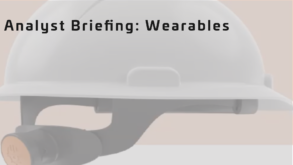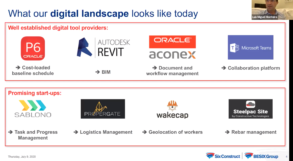
As with other smart job site IoT solutions, wearables are finally starting to make their way into more pilot programs on construction projects, as technologists and industry players sort through issues around ease of deployment, connectivity, and clarity of value propositions. Via this case study of a pilot program run on super tall building project Uptown Dubai, Daniel Pifko, VP North America for WakeCap joins Luis Miguel Monteiro, Project Director of Besix to discuss in depth how they leveraged wearables for workforce productivity and safety management.
Specifically, Wake Cap offers a hard hat mounted sensor that easily connects to a mesh network to provide location data and to analyze workflows around such things as site congestion, sign in and sign out, contacts tracing, and safety, time keeping, attendance.
Watch the Full Presentation by clicking here or on the image below and read more for an overview of the talk:

Founded in 1909, with more than 2.5 billion euros in revenue, the Belgium-based BESIX Group is a leader in construction, property development and concessions. The company specializes in buildings, infrastructure and marine work and works throughout Europe, the Middle East, and elsewhere. In the realm of technology, BESIX launched an open innovation program named Unleash in 2016 and then launched a start-up accelerator in 2018.
It was on a project called Uptown Dubai Phase I (minute 8:20 provides an overview) , a 340 meter super tall high rise tower with office, five star hotel, residential, and retail components being developed by Dubai-based, DMCC, that Besix partnered with Wake Cap.

Besix: Also a Case of Open Innovation at Global Scale
This case study offers another example of innovation fostered through international collaboration, and the discussion is interesting, not only for the specific technology case study, but also for the context offered around the journey Besix has taken in working with and melding emerging technology into their mature technology solution set to create a more robust tech stack that more fully meets their goal of achieving higher level predictive analytics.
The Project’s Tech Stack: Piloting New in Concert with Mature Solutions.
 They leveraged a range of technology companies on the project. Incorporated into their mature Oracle, Autodesk, and Microsoft stack, they added emerging solutions including ProperGate for logistics, WakeCap for geolocation of workforce, and German start up Sablono with an activity tracking software to monitor thousands of activities across the job from engineering, through procurement, and then into EPC. Working with these three added solutions together with their established technologies, Besix was able to gather much more data for more robust analysis of activity on the project. Other technologies they tested include Barcelona-based Scaled Robotics, and Dubai and UK-based, Steelpac Site for rebar management.
They leveraged a range of technology companies on the project. Incorporated into their mature Oracle, Autodesk, and Microsoft stack, they added emerging solutions including ProperGate for logistics, WakeCap for geolocation of workforce, and German start up Sablono with an activity tracking software to monitor thousands of activities across the job from engineering, through procurement, and then into EPC. Working with these three added solutions together with their established technologies, Besix was able to gather much more data for more robust analysis of activity on the project. Other technologies they tested include Barcelona-based Scaled Robotics, and Dubai and UK-based, Steelpac Site for rebar management.
Back to the In-Depth Considerations About Wearables
At minute 13:30 in the presentation, we get a much more in depth look at how WakeCap works on the site. It is a very nice explanation of what a mesh network is and how it gets deployed as well as how the hard hats are used for geolocation. Then, at around minute 18:32, we return to the case study of Uptown Dubai to see the kinds of data the Besix team is able to derive from the hard hats.
Beyond simply knowing where people are on the job site, the Besix team points to some really interesting ways in which the data can help provide insights around areas of lost productivity which then become opportunities for improvements.
The Critical Issues of Solution Deployment and Reliability
At minute 34:00 in the presentation, conversation turns to the question of how easy it is to deploy the hard hats, how long they last, charging, power lines and supplies, wearability, and other logistics factors.
The Safety Features of Today’s Leading Wearables
Wearables often highlight the value they bring to workforce safety, and WakeCap’s smart hard hat case study is no exception. The hard hat offers geofencing to alert if someone enters a restricted areas, the ability to notify all wearing the hard hats of an event such as a need to evacuate, the ability to detect a fall, and also the ability for the wearer to make an emergency call for help if needed.
This conversation was recorded on Day 2 of the 2020 BuiltWorlds Project Delivery Conference. For more information about how to access this case study recording, other case studies and resources, online conferences, and the full suite of the BuiltWorlds network’s learning and connecting tools, visit Join the BuiltWorlds Member Network to find out more.



Discussion
Be the first to leave a comment.
You must be a member of the BuiltWorlds community to join the discussion.